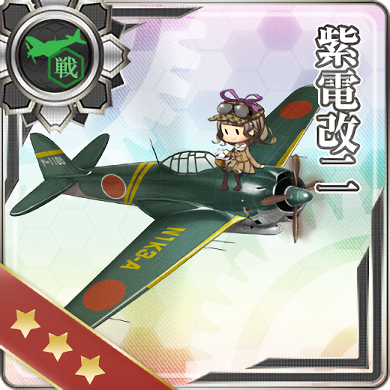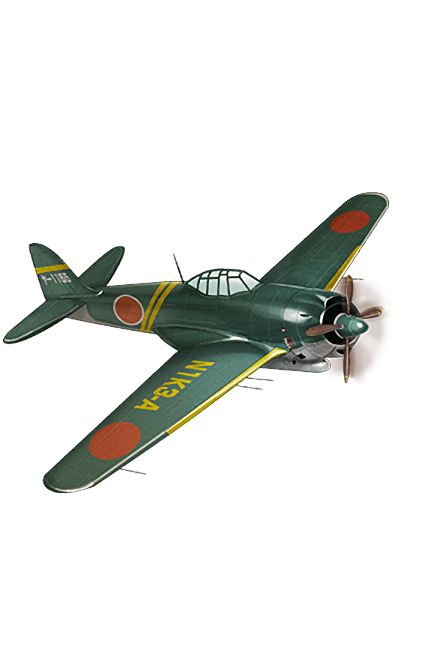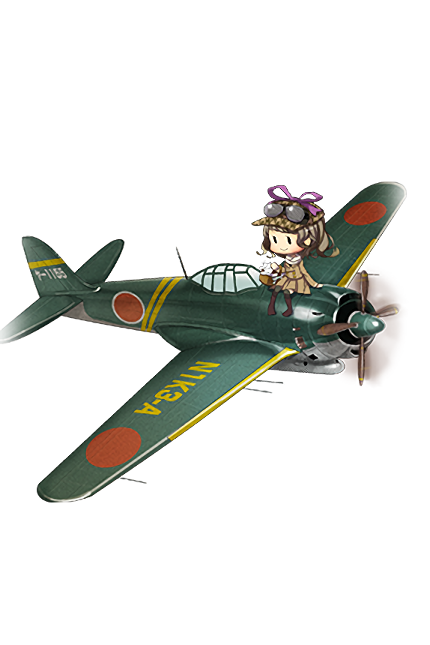- Welcome to the Kancolle Wiki!
- If you have any questions regarding site content, account registration, etc., please visit the KanColle Wiki Discord
Shiden Kai 2
[Edit]
Violet Lightning Mk.2
No.55 紫電改二
| |
| Refittable Ship Types | |
| Coastal Defense Ship | Destroyer |
| Light Cruiser | Torpedo Cruiser |
| Heavy Cruiser | Training Cruiser |
| Aviation Cruiser | Fast Battleship |
| Battleship | Aviation Battleship |
| Light Carrier | Standard Aircraft Carrier |
| Armored Carrier | Seaplane Tender |
| Submarine | Aircraft Carrying Submarine |
| Submarine Tender | Fleet Oiler |
| Repair Ship | Amphibious Assault Ship |
| LBAS Plane | |
Introduction
本土防空の切り札、局地戦闘機「紫電改」の艦載機型です。
大馬力エンジンと空戦フラップの採用などによる優れた空戦能力で、開発・配備の遅れた烈風の穴を埋めるべく計画されました。
空母信濃が就航した暁には、たとえ烈風や烈風改が揃っていても、あえて搭載して欲しい幻の…
そして実在した最後の艦上戦闘機です。
The carrier-based variant of the trump card of mainland air defense, a domestically designed fighter, "Shiden Kai".
Intended to fill the gap left by the delays in development and deployment of the "Reppuu", its excellent dogfighting capability is due to its high-powered engine and air-flaps.
Even if the dawn that the aircraft carrier Shinano was in service, equipped with Reppuu and Reppu Kai is but a faraway vision...
This is the last of the carrier-based fighters that was real.
Notes
How To Obtain
Uses
Used to improve Shiden Kai 2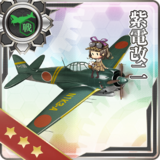 , Shiden Kai 4
, Shiden Kai 4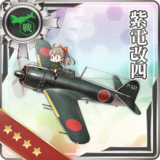 , Shiden Model 11
, Shiden Model 11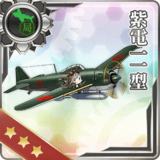 , F6F-3
, F6F-3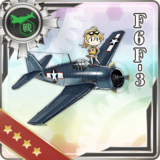 , F6F-5
, F6F-5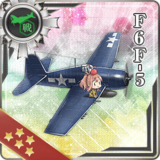 , Kyoufuu Kai
, Kyoufuu Kai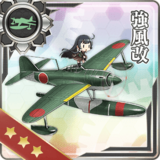 , Zuiun Kai Ni (634 Air Group)
, Zuiun Kai Ni (634 Air Group)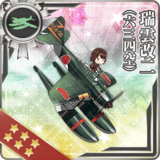
Used by quests: F46
Updates History
- 2013-05-08: Added to game data and announced to be obtainable in the future
- 2013-05-15: Implemented
- 2015-10-30: Stats increased:
 +0 →
+0 →  +3
+3 - 2021-09-28: Became improvable and upgradeable to Shiden Kai 4

Akashi's Improvement Arsenal
| Type | Name | ★ | Resource | Day | 2nd Ship | Note | ||||||||||||
|---|---|---|---|---|---|---|---|---|---|---|---|---|---|---|---|---|---|---|
| Sun | Mon | Tue | Wed | Thu | Fri | Sat | ||||||||||||
| Shiden Kai 2 | 0 | 110 | 160 | 0 | 330 | 5/7 | 4/5 | 1x |
X | ✓ | ✓ | ✓ | ✓ | X | X | Suzuya Carrier Kai Ni
|
Upgrades to Shiden Kai 4 . .
| |
| 6 | 8/10 | 5/7 | 2x | |||||||||||||||
| 10 | ?/20 | ?/9 | 2x 1x 1x | |||||||||||||||
Trivia
Historical Information
The Kawanishi N1K3-A Model 41 Shiden Kai Ni (Violet Lightning, Modified 2, Allied reporting name "George") was a proposed carrier-based variant of the Kawanishi N1K2-J. The N1K2-J was a land-based version of the Kawanishi N1K Kyōfū (Strong Wind, Allied reporting name "Rex") floatplane fighter. The N1K was the last production line of fighter planes manufactured and flown by the Japanese Navy Air Service. Both its pilots and opponents considered the N1K-Js to be among the finest land-based fighters of Japan.
Originally developed as a floatplane fighter for forward-operations support where runways would not be available, the N1K was introduced to service in 1943. However, at that point Japan was no longer on the offensive, depriving the N1K of its intended role. With its heavy floats, it was at a severe disadvantage against contemporary American fighter planes, leading Kawanishi engineers to propose in 1941 to make a land-based fighter based on the N1K.
Produced as a private venture by Kawanishi with the more powerful 1,850 hp Nakajima NK9A Homare 11 engine replacing the Mitsubishi MK4C Kasei 13 engine, the prototype N1K fighter flew in December 1942. It still carried the mid-mounted wing of the original floatplane design, which with its large propeller, required a long, stalky landing gear. It had a unique set of automatic combat flaps that were acceleration-sensitive, reducing the likelihood of a stall in combat. However, it was susceptible to entering an unrecoverable spin if handled roughly, making it extremely dangerous for inexperienced pilots.
The NK9 engine, although powerful, was unrefined due to its rush to production. Aside from the problematic engine, poor heat-treatment of the wheels could cause the landing gear to break off when the fighter attempted to land. It was reported that more N1Ks were lost by landing-gear failures than to Allied forces. Despite these problems, the Kawanishi fighter was deemed promising and subsequently evaluated by the Navy. As it was faster than the Mitsubishi A6M5 (Zero-fighter Model 52) in service at the time, had an even longer range than the Mitsubishi J2M Raiden interceptor and the 17-shi project (the Mitsubishi A7M Reppū) was facing trouble, the prototypes were ordered into production as the N1K1-J. The J suffix indicates a land-based fighter modification, just as a J-prefix indicates a purpose-designed land-based fighter.
The N1K1 entered service in early 1944 and proved highly effective against American fighters, being the only one of its contemporaries that could match its enemies - F6F Hellcats and F4U Corsairs - and even outperform them with the guidance of an ace pilot. Rare for a Japanese fighter was the N1K's resilience, a significant upgrade from the fragile Zero-fighters. Although formidable, the N1K1-Js were still unreliable - both the troublesome NK9 engine and complicated undercarriage frequently failed. Altogether, 1,007 N1K1-Js were produced, including prototypes.
Merely four days after the N1K1-J's first test flight, the N1K2-J's development had begun. This new design resolved the N1K1-J's teething issues, such as the mid-mounted wing and poor landing gear design. The wings were lowered, facilitating a shorter, conventional undercarriage, while the fuselage was longer and the tail redesigned. The N1K2-J was also designed to be substantially easier to produce with just over a third of the parts of the N1K1-J. The Nakajima NK9 engine was retained as no viable alternative was available, despite its still questionable reliability.
The N1K2-J prototype flew on New Year's of 1944 and completed trials from the Imperial Japanese Navy in April 1944. It was subsequently rushed into production as the Shiden Kai and entered service that same year. In February 1945, a group of N1K2-Js encountered seven Hellcats of the U.S. Navy, downing four with no loss.
The N1K2-J was one of the best dogfighters of World War II, boasting both high speed (greater than 650 km/h), incredible agility, and a quartet of 20 mm cannons. Its performance as a bomber interceptor, however, was lackluster - it had a poor rate of climb and reduced engine performance at a high altitude. Production difficulties and bombing raids on factories only allowed a mere 415 N1K2-Js to be produced, placing them in the hands of elite units such as the Navy's 343rd Air Group. It was fielded together with Nakajima C6N Saiun reconnaissance planes.
Regardless of the Kawanishi fighters' excellence in firepower, agility, and resilience, they were produced too late and in too few numbers to change the favor of the war. It did however spawn several variants, both prototypes, and production, such as the N1K2-Ja Model 21A (a fighter-bomber). The prototypes of the planned N1K3-J series had different engine placement and twin 13.2 mm machine guns.
The N1K3-A Shiden Kai Ni Model 41 as seen in Kancolle, was a project designed to be a carrier-based version of the aforementioned N1K3-J. No prototypes of the N1K3-A were ever built. Its name, 「紫電」- "Violet Lightning", likely refers to the pink lightning phenomenon - a common, more violent, louder, pink or purplish colored storm lightning bolt.
